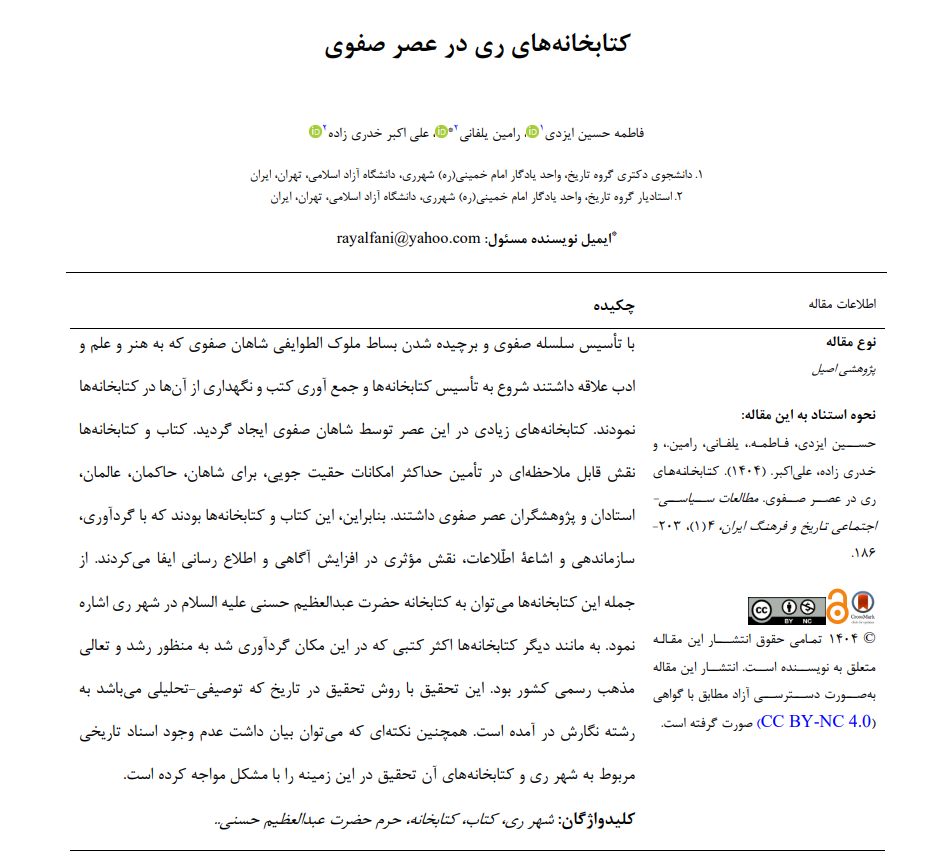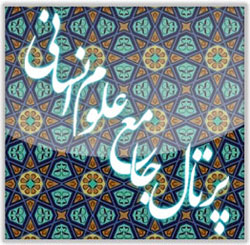Libraries of Rey during the Safavid Era
Keywords:
Ray city, book, ,shrine of Hazrat Abdul Azim Hosni, libraryAbstract
With the establishment of the Safavid dynasty and the dissolution of the feudal lords, the Safavid monarchs—who were inclined toward art, science, and literature—initiated the founding of libraries and the collection and preservation of books within these institutions. Numerous libraries were established during this period by the Safavid kings. Books and libraries played a significant role in maximizing the resources available for the pursuit of truth by the monarchs, governors, scholars, teachers, and researchers of the Safavid era. Therefore, it was through books and libraries that, by means of collecting, organizing, and disseminating information, a vital role in the enhancement of awareness and knowledge dissemination was fulfilled. Among these libraries, reference can be made to the library of Hazrat Abd al-Azim al-Hasani (peace be upon him) in the city of Rey. Similar to other libraries, most of the books collected at this location were aimed at fostering and elevating the official religion of the state. This study has been written using the historical research method, which is descriptive-analytical in nature. It is also worth noting that the absence of historical documents pertaining to the city of Rey and its libraries has posed challenges to research in this area.
Downloads
References
Ajand, Y. (2005). Library and painting house organization in the Isfahan school. Golestan-e Honar Journal.
Ajand, Y. (2012). From workshop to university. Tehran: Academy of Arts.
Aqili, A. (2001). History of the shrine of Rey. Qom: Dar al-Hadith Publishing, in collaboration with the Cultural Department of the Holy Shrine of Hazrat Abdul Azim.
Atarodi, A. (1994). The life of Hazrat Abdul Azim (peace be upon him). Tehran: Attardi Publishing.
Babaei, S., & Amiri, M. (2019). Isfahan and its palaces. Tehran: Javid Publishing.
Badkoubeie Hozavei, M. (2010). Khajeh Nasir al-Din Tusi. Tehran: Iran Library Development Publishing.
Borjian Boroujeni, M. (2023). Libraries of the Safavid era: Continuity and transformation in approaches. Library and Information Quarterly.
Derayati, M. (2011). Catalog of Iranian manuscripts. Tehran: National Archives and Library of Iran.
Hafez Abrou, S. A. K., & Kamal Haj Seyed Javadi, S. (2001). Zobdat al-Tawarikh. Tehran: Ministry of Culture and Islamic Guidance Publishing.
Homayoun Farokh, R. D. (1968). The royal libraries of Iran from the advent of Islam to the present age. Tehran: Ministry of Culture and Art Publishing.
Jafarian, R. (2010). The Safavids in the realm of religion and culture. Qom: Research Institute of Seminary and University.
Mir Ahmadi, K. (1990). Religion and state during the Safavid era. Tehran: Amir Kabir Publishing.
Mousavi Ardabili, F. (1968). History of Ardabil and its scholars. [No publisher].
Price, C. (1968). A history of Islamic art. Tehran: Amir Kabir Publishing.
Qaidan, A. A. (1964). Hazrat Abdul Azim (peace be upon him) and the city of Rey throughout history. Qom: Dar al-Hadith.
Rashid al-Din Fazlullah, H., Minavi, M., & Afshar, I. (1971). Waqfnameh of Rab' Rashidi. Tehran: National Heritage Association.
Safat Gol, M. (1998). Iran during the Safavid era from Chardin's perspective. Monthly Book of History and Geography.
Sahafi Nejad, S. M., & Zamani Nejad, A. A. (2003). A biography of Hazrat Abdul Azim Hasani and the city of Rey. Qom: Dar al-Hadith.
Yaqut Hamawi, Y. b. A. (1965). Mu'jam al-Buldan. Tehran: Asadi Publishing.








